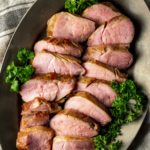
The Best Sous Vide Pork Tenderloin with Sauce
Sous Vide Pork Tenderloin is tender, juicy and flavorful, and cooks to your desired level of doneness without drying out!
Servings 6 people
Calories 397kcal
Ingredients
- 1 ½ - 2 pounds pork tenderloin 2 tenderloins
- 1 ½ tablespoons salt
- ¼ cup maple syrup
- ½ teaspoon orange zest
- 1 teaspoon freshly squeezed orange juice
- 1 tablespoon dry sherry
- 2 garlic cloves smashed
- ¼ cup brown sugar
- 2 tablespoons soy sauce
- 1 tablespoon apple cider vinegar
- ¼ teaspoon pepper
- ½ teaspoon paprika
Instructions
- Rub the salt all over the pork tenderloins and let them sit, uncovered, in the fridge overnight.
- Heat a sous vide water bath to 134°F degrees for rare or medium-rare (see table above for more options).
- Combine the remaining ingredients in a bowl and mix well to combine.
- Place the pork in a vacuum sealable bag (or ziplock freezer bag if using the water displacement method above) and pour the liquid over the top.
- Use the moist setting on the vacuum sealer to seal.
- Place in the water bath and cook for 1-4 hours.
- Remove the pork from the sous vide bag and reserve the bag juices in a small saucepan to make a pan sauce. Pat dry with paper towels for the surface of the pork is as dry as possible (this helps it sear faster).
- Heat a cast iron skillet on high heat until almost smoking. Add 1 tablespoon of avocado oil (or any high smoke point oil).
- Sear the pork tenderloins for 45-60 seconds per side, until a brown crust has formed (be very careful not to overcook here).
- Simmer the reserved bag sauce in the saucepan about 5 minutes. If the sauce is too salty, you may need to add chicken stock to even it out.
- Remove from the pan and let cool for 5 minutes. Slice and serve with reserved bag juice.
Notes
- The pork may float in the water bath. For even cooking, they should be completely submerged. To prevent floating, you can way the bag down with something heavy, use sous vide magnets or this sous vide sinker weight. Remove as much air as possible from the bag to prevent it from floating.
- If air gets in the bag, just open the bag, let the air out and reseal it.
- For the best crust, use some paper towels to pat it dry before placing it in the hot skillet.
- The skillet should be extremely hot before adding the pork so it sears quickly without overcooking.
- Don't sear the pork for more than 45-60 seconds per side as it can overcook.
- Omit the sherry in the marinade if you prefer and just substitute with vegetable or chicken stock.
- Remove the silver skin before cooking if your pork has it. This is a thin membrane often found on the surface of tenderloins (it's a bluish iridescent color).
- Add 45 to 60 minutes to the cooking time for frozen pork.
Nutrition
Serving: 4ounces | Calories: 397kcal | Carbohydrates: 19g | Protein: 55g | Fat: 9g | Saturated Fat: 3g | Polyunsaturated Fat: 2g | Monounsaturated Fat: 4g | Trans Fat: 1g | Cholesterol: 172mg | Sodium: 2803mg | Potassium: 1108mg | Fiber: 1g | Sugar: 17g | Vitamin A: 89IU | Vitamin C: 1mg | Calcium: 44mg | Iron: 3mg